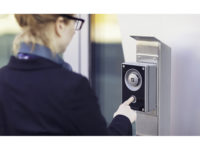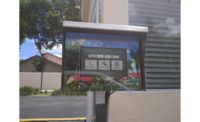2020 has been a big year for innovation in the security industry — and entry control is far from exempt. The COVID-19 pandemic has put an increased focus on the entrance, as many companies had to restrict entry to a select few considered to be essential, and others found themselves paying closer attention to who was entering their buildings.
“Now more than ever there is a need to interact and communicate with individuals moving in and out of spaces, and with this comes the need to provide frictionless access without physical intervention,” says Dan Rothrock, president, security and safety, Americas, Zenitel, Kansas City, Mo. “Due to COVID-19, there is increased use of biometric and touchless devices, and intelligible audio should be a key part of these solutions.”
The security industry has risen to the occasion, creating innovative entry control products and solutions to meet the new needs of building managers. Being able to admit entrance to visitors in a frictionless and remote way is certainly in demand in the pandemic.
“Entry control as a whole has had to make big changes to accommodate the newest threat: COVID-19,” says Mike Busby, marketing and sales manager, Viking Electronics, Hudson, Wis. “Unlike other threats, this one is invisible — which makes it much harder to keep out. Business owners and installers have had to rethink entry control and find ways to follow the ever-changing regulations, while maintaining the security of the business and the safety of the people.”
Luckily, many manufacturers have been working on these features long before Anthony Fauci was a household name.
“The entry control space has been slowly evolving over the past few years to a new reality that’s without an actual receptionist or individual monitoring an access point,” says Paul Hefty, technical sales and support engineer II at Aiphone, Redmond, Wash. “Now with COVID-19 and more people working from home, this idea of a reception-free entry has only gained traction. We are hearing more and more from end users that they want a video intercom to be able to greet guests.
SDM Presents: Entry Control With Aiphone
SDM Presents: Entry Control With Camden
SDM Presents: Entry Control With Connected Tech
SDM Presents: Entry Control With Dormakaba
SDM Presents: Entry Control With Viking
SDM Presents: Entry Control With Zenitel
“In the past, we had a video door station to let visitors into the building, however, now once they gain access, they can also have a station act as the reception. Users can offer a personal message to visitors, allowing them to call a specific station, or select one from a list. Once the call is answered, they can have two-way video communication. This allows the employee to more easily identify the visitor, giving them peace of mind and a greater added sense of safety and security.”
Mike Simon, managing partner, Connected Technologies, Monument, Colo., notes the extended value proposition of security, which now encompasses safety and health.
“With this shift comes the need to address safety, liability and possible contagions as part of the entry control process,” Simon says. “Entry control solutions are not only managing access into the facility, but are now charged with helping businesses get back to work safely while keeping access secure.”
Mark Borto, vice president of sales, entrance and physical access systems, dormakaba Americas, Indianapolis, says the ability to integrate popular technologies into entrance products has had a positive impact in the sector.
“Entry control is becoming smarter and more seamless — smarter with increased integration within the building management systems, and seamless with design and intuitiveness — providing a more comfortable and convenient user experience,” Borto says.
Camden Door Controls Vice President of Communications & Corporate Development David Price has seen a variety of technologies becoming more popular in the entry control space over the past year.
“The market is stampeding away from manually opening doors, including the need for a hand to push a button or turn a lockset,” Price says. “This is driving the rapid adoption of not only no-touch devices (such as touchless switches activating an automatic door operator) and low-touch devices (such as 36” push plate switches that can be activated by an arm, knee or foot), but even the use of proximity readers with a longer range.”
Since none of us were able to explore all of these new technologies while strolling trade show floors this year, SDM conducted our own virtual ‘booth tours’ with these manufacturers to learn more about their solutions. So push play, sit back and enjoy — without the sore feet!





